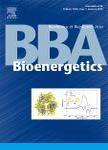版权所有:内蒙古大学图书馆 技术提供:维普资讯• 智图
内蒙古自治区呼和浩特市赛罕区大学西街235号 邮编: 010021

作者机构:UNIV ILLINOIS DEPT PLANT BIOL USDA ARS URBANA IL 61801 USA
出 版 物:《BIOCHIMICA ET BIOPHYSICA ACTA》 (Biochim. Biophys. Acta Bioenerg.)
年 卷 期:1988年第933卷第2期
页 面:258-268页
核心收录:
学科分类:0710[理学-生物学] 071010[理学-生物化学与分子生物学] 07[理学]
基 金:CompetitiveR esearchG rants Office of the US Departmenotf Agriculture (A G 86-CRCR-1-1987)
主 题:Cytochrome b f complex Electron transport inhibition Slow electrogenic step Binding site C 50 the concentration of inhibitor required to give 50% of the maximum inhibitory effect cytochrome b f complex plastoquinol-plastocyanin oxidoreductase complex DBMIB 2,5-dibromo-3-methyl-6-isopropyl- p -benzoquinone DCMU 3-(3,4-dichlorophenyl)-1,1-dimethylurea DQH 2 duroquinol HQNO 2- n -heptyl-4-hydroxyquinoline N -oxide I 50 the concentration of inhibitor required for 50% inhibition of the control signal NQNO 2- n -nonyl-4-hydroxyquinoline N -oxide P-700 + the oxidized primary electron donor of Photosystem I Tricine N -[2-hydroxy-1,1-bis(hydroxymethyl)-ethyl]glycine UHDBT 5-( n -undecyl)-6-hydroxy-4,7-dioxobenzothiazole Q c putative quinone binding site on the cytochrome b f complex located near the outer aqueous phase (stroma) Q z putative quinol binding site on the cytochrome b f complex located near the inner aqueous phase (lumen) 515 s the slow phase of the electrochromic shift (rise time 3–5 ms) Hepes 4-(2-hydroxyethyl)-1-piperazineethanesulfonic acid Tricine N -[2-hydroxy-1,1-bis(hydroxymethyl)ethyl]glycine
摘 要:We investigated the interaction between the cytochrome b/f complex and plastoquinone by determining the effect of the electron transport inhibitors 2-n-nonyl-4-hydroxy-quinoline N-oxide (NQNO) and 2,5-dibromo-3-methyl-6-isopropyl-p-benzoquinone (DBMIB) on the flash-induced turnover of cytochromes b6 and f, on the slow phase of the electrogenic reaction (515s) and on steady-state electron transport. The experiments were performed using thylakoid membranes in the presence of duroquinol, methyl viologen, and diuron, conditions in which electron transport is driven by Photosystem I and includes the cytochrome b/f complex. The data from these experiments indicate that NQNO and DMBIB inhibit at two different sites on the cytochrome b/f complex. The data can be accommodated by a modified Q-cycle in which the primary site of inhibition by NQNO is the quinone reductase site (Qc) and the primary site of DBMIB inhibition is the quinol oxidase site (Qz). NQNO is envisioned to inhibit the oxidation of the cytochrome b6-heme located nearest the outer aqueous phase, as well as to slow electron transfer between the two b-hemes. The effect of NQNO on the 515s supports the notion that the slow electrogenic reaction is due to electron transfer between the two cytochrome b6-hemes, followed by a reaction associated with plastoquinone reduction at the Qc-site (Jones and Whitmarsh (1985) Photobiochem. Photobiophys. 9, 119-127). The results indicate that the Qz-site and Qc-site are likely separated by 70% of the dielectrically weighted distance across the membrane. At low concentrations of DBMIB the kinetics of the 515s and cytochrome b6 reduction are monophasic, indicating that DMBIB moves from one inhibitory site to another within the turnover time of the cytochrome b/f complex. This observation suggests that the debinding rate of DBMIB on the extent of cytochrome f oxidation and the rate of cytochrome f reduction, raises the possibility that DBMIB has a second lower affinity binding sit